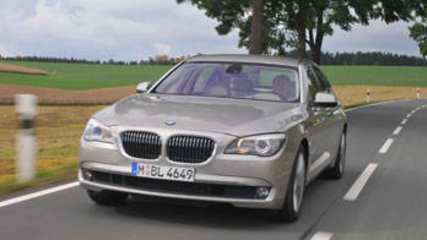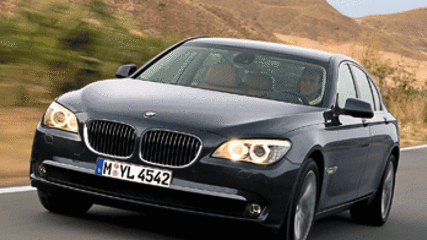BMW 750iL 2009 review
By Paul Gover · 19 Oct 2008
It feels good to be behind the wheel of the new BMW 7-Series. It's a car to drive and enjoy, as well as a technology flagship and styling pacesetter.A lot of what was lost or misplaced in the previous Seven — a brutal battleship on many fronts — has come back and that is good news. The styling, too, has been pulled back from confrontational to make-a-statement bold.“This is the very best of BMW. This embodies the flagship of the business,” BMW global sales and marketing chief Ian Robertson says.That means it is packed with technology and engineering, from the first double-wishbone front suspension in a Seven to a user-friendly upgrade of the lacklustre iDrive system, and new safety systems including one that can read speed signs and update the driver.It is also a little lighter yet is just as big and quick. Updated petrol and diesel engines range from an in-line diesel six, which should become the Australian favourite next year, to the twin-turbo V8 that is already a hit in the X6.The best news for top-end shoppers is that the focus has returned to the driver's seat, after an experiment with a car that was more enjoyable as a chauffeured ride.The dash is now wrapped around the driver and the gear selector is back in the centre console.All the changes reflect a return to the basics that made the Seven so good from the late 1970s, even if there is no admission of any mistakes with the previous car.“The predecessor was not without controversy. Nevertheless, it made a statement,” Robertson says.And you cannot call it a failure because it sold in record numbers.But a lot of people will welcome the new Seven, which will arrive in Australia in March with a starting price a little below $200,000. It will be available for the first time with short and long-wheelbase bodies from the start, and an 240kW in-line six for the 740 and 300kW V8 for the 750.Final specifications are still being set, but it is fair to expect the usual combination of airconditioning and premium sound and alloys in the short-wheelbase car, and electric rear seats and a DVD entertainment package in the iL cars.But no one knows yet about the availability of the new four-wheel steering system for the Seven, or the infra-red night vision, or the lane-departure warning or . . .Mechanically, BMW makes the usual claims for a new car — more power and torque for less fuel and emissions. But it has its commitment to Efficient Dynamics and the results are impressive.“The 7-Series has always been a technological spearhead with ultimate comfort and elegance,” chief engineer Johann Kistler says.The 740's six has 6.7 per cent more power with an 11.6 per cent cut in fuel consumption, down to 9.9 litres for 100km, and CO2 is cut 13.1 per cent to 232g/km.The V8 in the 750 has 11 per cent more power, isbmw 7-series peice line-ball on economy and is down a little on C02, to 266g/km.THE BMW 7-Series is a good drive. No, it's better than that. It's a terrific drive.It is a big car, even as a short-wheelbase 730i, yet it shrinks around you and allows you to cover long distances with minimal fuss. It has sporty performance, with loads of luxury, yet is not demanding or nasty.Best of all, after the previous Seven, it is a welcoming car that is easy and rewarding to drive.I was not a fan of the previous Seven, partly because of its nasty iDrive and a cabin which was confrontational and hard to learn, but the failure for me was that it was not a driver's car.Previous Sevens were built to drive, but the last one was a back-seat special loaded like a Harvey Norman showroom.Not now. The new 7-Series has more technology than any car I have driven but it is easy to use and adds to the experience.The rear-steer system makes the long-wheelbase iL easy to turn in a narrow street, the safety gear is all unobtrusive and useful — including the speed-limit camera — and it is good to know the engines are so lean and efficient.Still, visibility can be a problem, there was some wind noise on one of the German test cars, and some people complain that getting into the low-seat rear seats can be a problem. But those are minor niggles.BMW only had the short-wheelbase 730d diesel and the long-wheelbase 750iL to assess on global press preview at Dresden in the former East Germany, and all the cars were loaded.But the basics show how good the car is for 2009 and beyond and reflect a return to the traditional values of the Seven.The cars are crisp and responsive and there is absolutely no indication that the 730d has a diesel six under the hood. The V8 in the 750 is a cracker and easily took the car to its 250km/h top speed on an unrestricted autobahn.They have traditional rear-wheel drive with six-speed autos that slur through the ratios but respond well to a touch on the tiptronic lever. Something else back in the Seven . . .There is a lot to like in the new 7-Series. Best of all, it proves BMW is prepared to step back to go forwards — even if no one admits there was anything wrong with the previous car.









